
hotline:
17715390137
Tel/Wechat:
18101240246 (Technology)
0512-68565571
Email:mxenes@163.com (Sales Engineer)bkxc.bonnie@gmail.com
Scan the code to follow or search the official account on WeChat:
2D Materials Fronrier After paying attention,
click on the lower right corner to contact us,
Enter enterprise WeChat.
Professional Services Online

I. Introduction to Research Background of Porous Materials
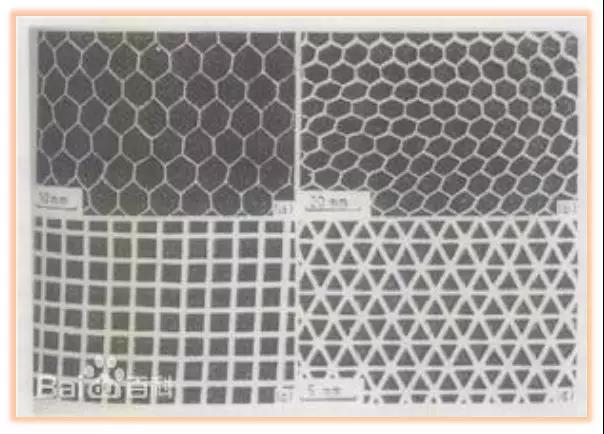 In recent years, research on porous materials has developed rapidly. As a new favorite of materials, the potential of porous materials is unlimited. According to the pore size classification, it is divided into micropores (Φ <2nm), mesopores (2nm≤Φ≤50nm) and macropores (Φ> 50nm). According to the material, it is divided into porous metal materials and non-metallic porous materials. Its outstanding features are excellent mechanical properties, propagation properties, photoelectric properties, permeability, adsorption properties, and chemical properties. Porous materials have a wide range of applications in many fields such as macromolecular catalysis, space materials, adsorption and separation, optoelectronic devices, nanomaterial assembly, and biomedicine. Below we have compiled the latest scientific research progress on porous materials research in JACS and Angew magazine, and exchanged discussions together.
In recent years, research on porous materials has developed rapidly. As a new favorite of materials, the potential of porous materials is unlimited. According to the pore size classification, it is divided into micropores (Φ <2nm), mesopores (2nm≤Φ≤50nm) and macropores (Φ> 50nm). According to the material, it is divided into porous metal materials and non-metallic porous materials. Its outstanding features are excellent mechanical properties, propagation properties, photoelectric properties, permeability, adsorption properties, and chemical properties. Porous materials have a wide range of applications in many fields such as macromolecular catalysis, space materials, adsorption and separation, optoelectronic devices, nanomaterial assembly, and biomedicine. Below we have compiled the latest scientific research progress on porous materials research in JACS and Angew magazine, and exchanged discussions together.
Second, JACS / Angew‘s new research progress on porous materials
1.JACS: Direct monitoring of phase changes in metal-organic frameworks by in-situ variable temperature liquid cell transmission electron microscopy and in-situ X-ray diffraction
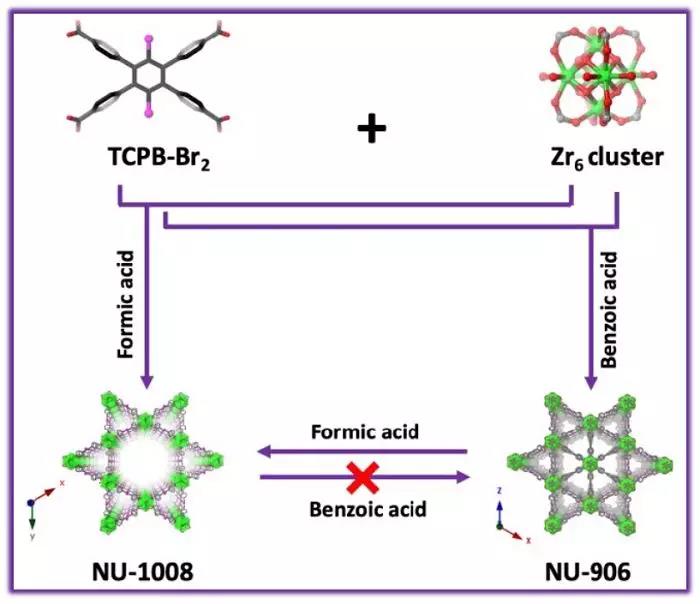
Professors Omar K. Farha and Nathan C. Gianneschi of Northwestern University in the United States have synthesized two pure-phase MOFs with different topologies and different topologies constructed by different modulators by synthesizing two topological MOFs with different topologies, providing Correlation. Combining in-situ characterization, VT-PXRD, HRTEM, VT-LCTEM, the researchers studied the mechanism of dynamic MOF phase transitions. The results show that the phase transition from scu-NU-906 to csq-NU-1008 occurs through a dissolution-reprecipitation mechanism. Researchers anticipate and suggest that a combination of these technologies will be widely applicable, providing the mechanical principles of dynamic processes in general crystalline materials.
Literature link:
https://pubs.acs.org/doi/10.1021/jacs.0c00542
2. JACS: Limit-driven photophysics in Cage, COF, MOF and DNA
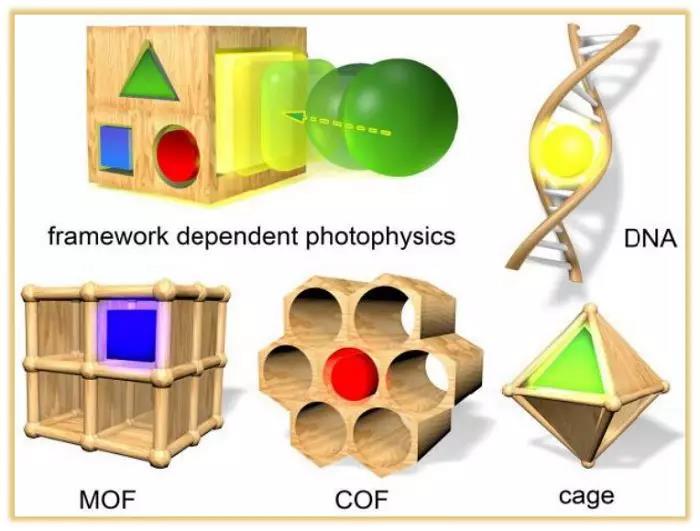
Professor Natalia B. Shustova‘s group at the University of South Carolina has revealed the potential for adjusting the photophysical properties of layered expansion materials in a confined environment. For the first time, the concept of using MOF as a variable and leaving the guest molecule unchanged to achieve phototunable profile tunability was explored. Researchers have used molecular cages as a truncation model for MOF to provide first mechanical insights on how restricted environments use X-ray diffraction and theoretical calculations to influence molecular reorganization and intramolecular hydrogen bonding. By providing first mechanical insights into the behavior of HBI chromophores in DNA-constrained spaces, researchers have extended their research beyond supramolecular assembly or layered materials. The first attempt to suppress non-radiative paths using a frame metal node is shown. This strategy provides a blueprint for discovering the structural and photophysical similarities between chromophores immobilized inside artificial MOF matrices and natural proteins. All in all, this study not only explains the mechanism of chromophore photophysics in a limited space, but also provides guidance for precisely tailoring the photophysical response of solid-state photoluminescent materials.
Literature link:
https://pubs.acs.org/doi/10.1021/jacs.9b13505
3. JACS: Bonding a covalent organic skeleton to a covalently bridged inorganic / organic hybrid to achieve efficient photocatalysis
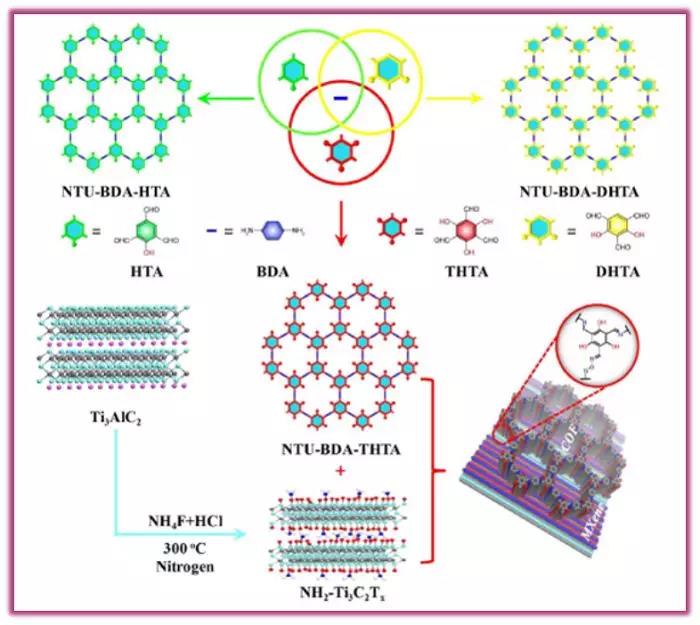
Prof. Yanli Zhao‘s group at Nanyang Technological University in Singapore has developed a method for constructing COF-based photocatalysts by combining bond evolution and covalent inorganic / organic heterostructures for visible light-induced hydrogen evolution from water. The imine moiety in NTU-BDA-HTA and NTU-BDA-DHTA may also inhibit the excited state of the mixed bond COF, thereby hindering the photoredox process. The results show that COF bonds can affect planar conformation, ordered structure, HOMO energy, and excited state quenching effects. Researchers have successfully demonstrated covalent attachment of inorganic MXene. Compared to conventional heterostructure controls that interact through non-covalent interactions such as van der Waals forces and hydrogen bonding interactions, these covalent hybrids show excellent photocatalytic activity and stability to the evolution of hydrogen from water. This "design screening and enhancement" strategy can rationally construct the COF and integrate it with other functional materials, thus opening the way for the development of efficient photocatalysts.
Literature link:
https://doi.org/10.1021/jacs.0c00054
4.JACS: a water-soluble flexible organic framework that encapsulates and delivers proteins
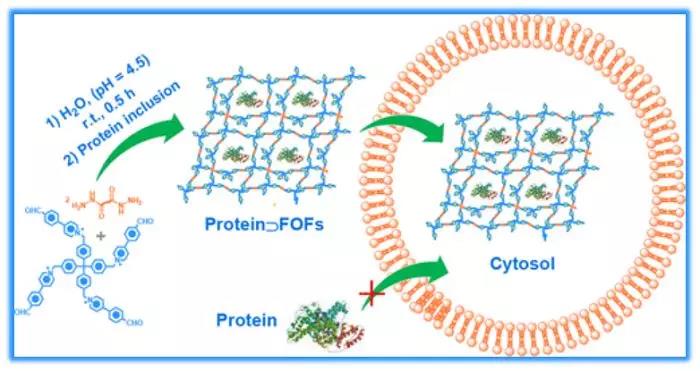
Li Zhanting, Zhou Wei, Zhang Yunchang of Fudan University, and Yi Liu of Lawrence Berkeley National Laboratory in the United States have demonstrated that water-soluble flexible organic frameworks with nanoscale pores can be prepared by forming dynamic bonds from readily available cations and hydrophilic precursors. The inherent porosity of the obtained dynamic covalent polymer was achieved by introducing a rigid tetraphenylmethane carrier, and the multivalent state induced by the tetramer can quantitatively form a fluorene bond, thereby forming a porous skeleton with a size exceeding 100 nm. The large pores of the flexible polymer backbone have both ionic and hydrophobic internal domains for containing different proteins for efficient intracellular delivery. Flexible porous organic frameworks represent the expansion of emerging crystalline covalent organic frameworks, which have been widely studied as solid materials. The combination of good water solubility and stability, controllable nanometer size, and ease of preparation may open the door for future applications of biocompatible soft materials.
Literature link:
https://pubs.acs.org/doi/10.1021/jacs.9b13263
5.JACS: Synthesis of ultra-stable molecular sieves by designing liquid-mediated processing

Professor Toru Wakihara of the University of Tokyo, Japan does not require additional liquid-mediated treatment with silylating agents (cooperative use of fluoride ions, hydroxide anions and pore filler cations) can stabilize high silica zeolites. The treated zeolite can withstand extremely high steam conditions. Defects in treated zeolites can be greatly reduced through self-defect repair mechanisms involving silicate material migration. The method proposed by the researchers is suitable for different zeolite structures with a certain aluminum content and mechanically damaged nano-sized zeolites. This extremely stable high silica zeolite will open up new adsorption and catalytic applications in which zeolite is subjected to severe high temperature steam conditions. In addition, these findings are expected to advance understanding of porous materials, including ultimate stability and migration mechanisms.
Literature link:
https://dx.doi.org/10.1021/jacs.9b12709
6.JACS: Polymer interface assembly induced synthesis of two-dimensional carbon nanosheets with multi-level channels
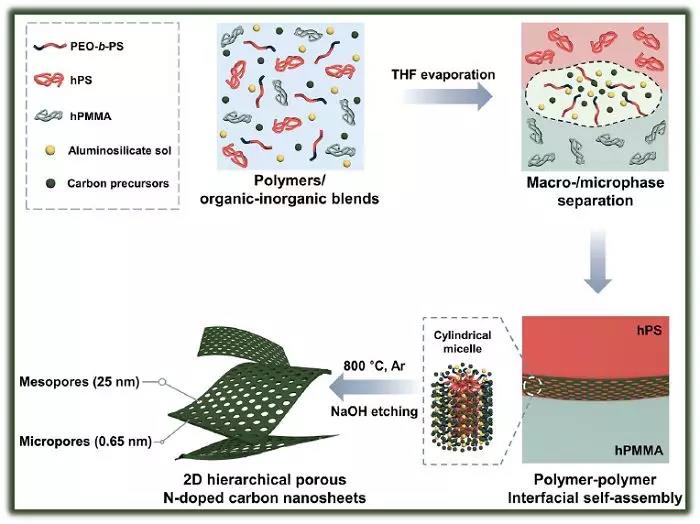
Professor Jinwoo Lee‘s group at the Korea Academy of Science and Technology has developed a PISA strategy to synthesize microporous and mesoporous 2D carbon materials by integrating macroscopic phase migration of ternary polymer mixtures and BCP-oriented self-assembly. The PISA method is simple and straightforward, and no additional hard template / substrate is needed to obtain 2D morphology. It can also independently control thickness (5.6-75 nm) and mesopore size (25-46 nm) simultaneously, which is difficult to achieve in other cases. This study provides new insights on how to take advantage of the physical properties and BCP phase behavior of ternary polymer blends, which can be used for the two-dimensional engineering of nanoporous inorganic nanosheets. Because the polymer‘s chemical composition / structure and polymer-polymer interfacial tension are highly controllable, this PISA method may make the design of two-dimensional porous materials highly structurally adjustable. Therefore, the PISA method has broad prospects as a general platform for 2D porous inorganic nanosheet synthesis for various potential applications such as catalysis, energy conversion / storage, and biological applications.
Literature link:
https://pubs.acs.org/doi/10.1021/jacs.0c00311
7. JACS: Ultra-thin two-dimensional membrane assembled using ion covalent organic nanosheets with reduced pore size for gas separation

Professor Dan Zhao‘s group at the National University of Singapore has developed an ultra-thin 2D film. The film is constructed by using two intrinsically-charged iCONs (with opposite charges and different pore diameters), driven by electrostatic interaction, layer by layer. . Due to the ultra-thin thickness of the separation layer (41 nm), the reduced pore size, and the dense and dense structure resulting from strong interlayer electrostatic interactions, the resulting hybrid TpEBr @ TpPa-SO3Na iCON membrane exhibits high H2 permeability ( 2566 GPU) and higher H2 / CO2 separation factor than a single single-phase iCON membrane at 423 K, which outperforms most reported membranes. In addition, due to strong covalent imine bonding and dense dense film structure in iCON, this hybrid film also shows long-term hydrothermal stability. TpEBr @ TpPa-SO3Na membrane not only provides candidates for hydrogen purification and pre-combustion CO2 capture, but also provides new inspiration for pore engineering of COF or 2D porous polymer membranes.
Literature link:
https://pubs.acs.org/doi/10.1021/jacs.9b13825
8.Angew: spider web metal organic frame multifunctional foam
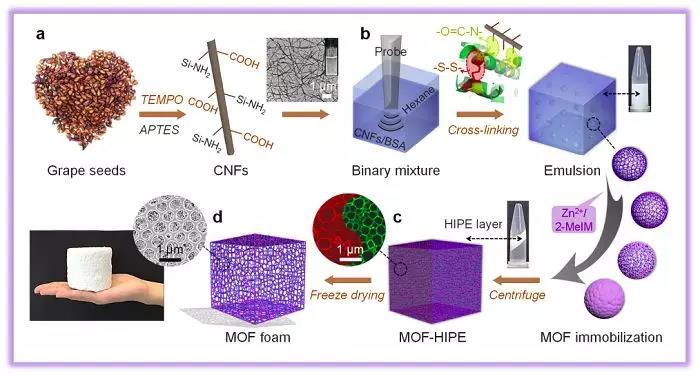
The research group of Professor Alireza Abbaspourrad of Cornell University in the United States synthesized a unique Zhonghong MOF platform through the HIPE template strategy. The platform is suitable for a variety of MOFs and biopolymers. The manufacturing process is universal, simple, environmentally friendly, and suitable for large-scale production ( Involves room temperature synthesis of traditional laboratory equipment). The findings of this study provide some advances in the field of MOF macromaterials, including good dispersion of MOF nanoparticles under high loads, well-defined layered porous systems, independent control of the structure of MOF, and large interconnected support bodies. Network of holes and simple fabrication of MOF composites by integrating other functional materials. The resulting spider web-like porous system has a high surface area and pore accessibility, and therefore has excellent adsorption and catalytic capabilities. With the ability to fine-tune the properties of this layered platform, this strategy offers strong potential for practical applications such as separation, catalysis, tissue engineering, controlled drug delivery, biology, and medicine based on MOF-based hybrid materials science.
Literature link:
https://doi.org/10.1002/ange.201916211
9. Angew: Improve the hydrogen evolution activity of Au (111) in alkaline medium through two-dimensional polymer molecular engineering
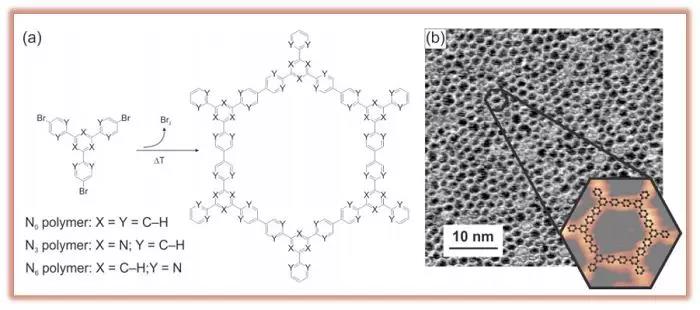
The research group of Professor Rico Gutzler of Max Planck Institute in Germany can improve the hydrogen evolution activity of gold electrodes in alkaline electrolytes by modifying the electrode surface with porous two-dimensional polymers. The polymer provides docking positions for H2O and H through hydrogen bonding, and increases the binding energy and the residence time near the electrode, thereby improving the catalytic activity. Hydrogen bonding sites of polymers are systematically engineered to regulate HER activity. The experimental results highlight the advantages of controlling the interaction of the reactants with the porous polymer patterned electrode to achieve a mixed organic / inorganic catalyst: by providing sufficient docking sites, the interaction of the reactants and intermediates with the electrode can be fine-tuned. It is expected that different docking sites on the polymer (such as hydroxyl or sulfur heteroatoms) will further adjust the hydrogen bonding interactions and place the reactants in the appropriate geometry to increase the activity. This paves the way not only for enhancing the catalytic activity of HER, but also for other electrocatalytic reactions on transition metal catalysts.
Literature link:
https://onlinelibrary.wiley.com/doi/abs/10.1002/anie.201915855
10.Angew: Construct SBA-15 / ZIF-8 multi-stage porous composite for insulin fixation

Professor Sun Linbing‘s group at Nanjing University of Technology has demonstrated that ZIF8 / AS with a new hierarchical structure is successfully constructed by manufacturing microporous MOFs in an uninterrupted mesoporous tunnel, which is in line with the reported HP based on mesoporous production in a microporous framework -MOF is different. Two factors are essential for the successful construction of layered porous materials, namely the highly dispersed ZnO precursor obtained in a limited space and the LVIC strategy for ZIF-8 crystallization. The LVIC strategy can almost quantitatively convert ZnO to ZIF-8, and can form an appropriate amount of ZIF-8 in a highly dispersed state in the mesopores. The obtained layered porous composite material with micropores in the uninterrupted mesopores showed high adsorption capacity for macromolecular trypsin. In addition, the thermostability and storage stability of trypsin were greatly improved after fixation. This strategy may open a way for the manufacture of layered structures with uninterrupted mesoporous tunnels, thereby facilitating mass transfer and active sites to enter macromolecules that are not accessible with conventional HP-MOF. This strategy can also be extended to other silicas with 3D mesoporous channels to make HP-MOFs with various pore systems.
Literature link:
https://doi.org/10.1002/anie.201915332

| Reminder: Beijing Beike New Material Technology Co., Ltd. supplies products only for scientific research, not for humans |
| All rights reserved © 2019 beijing beike new material Technology Co., Ltd 京ICP备16054715-2号 |